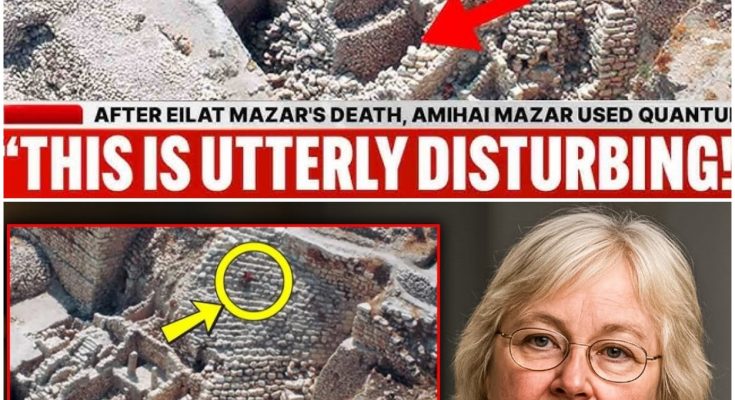The Hidden Truths of King David’s Palace: Dr. Eilat Mazar’s Final Revelation
In a shocking turn of events, the world of archaeology has been rocked by the revelations of Dr. Eilat Mazar, a leading figure in the excavation of what is believed to be King David’s palace in Jerusalem.
Known for her groundbreaking work, Dr. Mazar recently disclosed that her findings beneath the ancient ruins may rewrite history as we know it.
In her haunting final statements, she hinted at the discovery of hidden artifacts and ancient texts, culminating in a statement that left many in disbelief: “the world isn’t ready for” what she found.
What secrets lie buried beneath the stones of this ancient site, and why have they been kept from the public eye?
The Excavation of King David’s Palace
Dr. Eilat Mazar began her excavation of King David’s palace in the early 2000s, driven by a passion for uncovering the historical truths surrounding one of the most significant figures in biblical history.
Her work has been met with both acclaim and skepticism, as the debate over the historical accuracy of biblical accounts continues to captivate scholars and enthusiasts alike.

The site, located in the City of David, has yielded numerous artifacts, including pottery, seals, and inscriptions that provide insight into the life and times of ancient Jerusalem. However, it was Dr. Mazar’s latest discoveries that have ignited a firestorm of intrigue and speculation.
The Haunting Final Revelation
In a recent interview, Dr. Mazar spoke candidly about her discoveries, revealing that among the artifacts were ancient texts that could change our understanding of biblical history.
While she did not disclose the specifics of these texts, her assertion that “the world isn’t ready for” their implications suggests that they may challenge long-held beliefs about the biblical narrative.
This revelation raises critical questions: What do these texts contain? How might they alter our understanding of King David’s reign and the historical context of the Bible?
The archaeologist’s words echo with the weight of history, suggesting that the findings could have profound implications for both religious and secular scholars.
Why the Secrecy?
The secrecy surrounding these discoveries has sparked intense debate within the archaeological community. Some experts speculate that the implications of Dr. Mazar’s findings could be controversial, potentially challenging established historical timelines and interpretations of biblical events.
The idea that significant historical truths have been suppressed raises ethical considerations about the responsibilities of archaeologists to share their findings with the public.
Dr. Mazar’s reluctance to fully disclose her findings may stem from a desire to protect the integrity of the research process, or perhaps a recognition of the societal and cultural implications that such revelations could unleash.
The archaeology of biblical sites is fraught with tension, as the intersection of faith and history often leads to heated debates and differing interpretations.
The Impact on Historical Understanding
If Dr. Mazar’s findings are as groundbreaking as she suggests, they could significantly impact our understanding of ancient Israelite society and its governance.
King David is often portrayed as a unifying figure, a warrior king who established Jerusalem as the political and spiritual center of Israel. However, if new evidence suggests a more complex reality, it may force historians to reevaluate the narratives that have shaped our understanding of this pivotal period.
Moreover, the potential existence of ancient texts could provide invaluable insights into the cultural, political, and religious dynamics of the time.
Such documents might illuminate the daily lives of the people who lived during King David’s reign, offering a more nuanced view of their beliefs and practices.
The Future of Archaeological Research
As the archaeological community awaits further details from Dr. Mazar, the anticipation surrounding her findings underscores the excitement and challenges inherent in the field.
Archaeology is not merely about uncovering artifacts; it is about piecing together the stories of our past. Each discovery has the potential to reshape our understanding of history, prompting us to confront uncomfortable truths and reassess long-held beliefs.
The ethical implications of archaeological discoveries are becoming increasingly important as well. Scholars are tasked with balancing the desire to uncover the past with the responsibility to respect the cultures and communities connected to those histories.
Dr. Mazar’s revelations may serve as a catalyst for discussions about transparency and the dissemination of knowledge in the field.
Conclusion: A Call for Transparency
Dr. Eilat Mazar’s haunting final revelation has opened a Pandora’s box of questions about the past, challenging us to reconsider what we think we know about King David and the ancient world.
As the archaeological community grapples with the implications of her findings, it is crucial that the conversation remains open and inclusive.
Transparency in sharing discoveries not only honors the work of those who came before us but also enriches our collective understanding of human history.
As we await further details, one thing is clear: the story of King David’s palace is far from over. Dr. Mazar’s discoveries may very well lead us to a deeper understanding of the complexities of our shared past, inviting us to explore the truths that lie beneath the surface of history.



